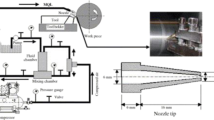Abstract
Manufacturing industries have been pressured to use less power and reduce pollution by the development of power-efficient and pollution-preventing policies from the government. However, quality and cost are of main concern in this agenda. In machining, the key solution for this issue is by increasing the effectiveness of existing lubrication systems as this reduces the power required to overcome the friction component in machining processes for less fuel consumption and pollution. In machining processes, in particular, improved lubrication systems will increase batch production rates with better product quality. Introducing nanolubrication reduces power consumption as the rolling action of a billion units of nanoparticles in the tool chip interface decreases the cutting forces significantly. Additionally, using nanolubrication in machining minimizes the consumption of the lubrication oil, which decreases pollution. Detailed analysis and implementation of nanolubrication in machining process with the proper parameter setup are mandatory to ensure the efficiency of implementing nanolubrication. In this research, SiO2 nanoparticles are mixed with ordinary mineral oil having 0.2% weight concentration. A proper sonification method is used to mix and suspend the particles thoroughly and efficiently. The results show a reduction in the coefficient of friction in the tool/chip interface. Hence, the cutting force and working power are reduced considerably compared with conventional lubrication systems. Consequently, considerable power savings, less oil consumption, and less pollution are achieved.
Similar content being viewed by others
References
Sidjanin L, Kovac P (1997) Fracture mechanisms in chip formation processes. Mater Sci Technol 13:439–444
Liewa WYH, Hutchings IM, Williams JA (1999) The interaction between tool material, environment, and process conditions in the machining of aluminium alloys. An International Journal Machining Science and Technology 3(2):273–286
Machado AR, Wallbank J (1997) The effect of extremely low lubricant volumes in machining. Wear 210:76–82
Klocke F, Eisenblätter G (1997) Dry cutting. Annals CIRP 46(2):519–526
Brinksmeier E et al (1999) Aspects of cooling application reduction in machining advanced materials. Proc Instn Mech Engrs 213:769–778
Brinksmeier E et al (1999) Aspects of cooling lubrication reduction in machining advanced materials. ImechE, Part B 213:769–778
Nasir A (1998) General comments on ecological and dry machining. In Network Proceedings “Technical Solutions to Decrease Consumption of Cutting Fluids,” Sobotin-Sumperk, Czech Republic. 1998. p. 10–14.
Sreejith PS, Ngoi BKA (2000) Dry machining: machining of the future. J Mater Process Technol 101(1–3):287–291
Li Y, Liang SY (1999) Cutting force analysis in transient state milling processes. Int J Adv Manuf Technol 15(11):785–790
Thepsonthi T, Hamdi M, Mitsui K (2009) Investigation into minimal-cutting-fluid application in high-speed milling of hardened steel using carbide mills. Int J Mach Tools Manuf 49:156–162
Qi H, Mills B (2000) Formation of a transfer layer at the tool-chip interface during machining. Wear 245:136–147
Itoigawa F et al (2007) Experimental study on lubrication mechanism in MQL intermittent cutting process. Machining Science and Technology: An International Journa 11(3):355–365
Claudin C, Poulachon G, Lambertin M (2008) Correlation between drill geometry and mechanical forces in MQL conditions. An International Journal of Machining Science and Technology 12(1):133–144
Agarwal S, Rao PV (2007) Performance improvement of sic grinding using solid lubricants. An International Journal of Machining Science and Technology 11(1):61–79
Zhang Z, Yan J, Kuriyagawa T (2011) Study on tool wear characteristics in diamond turning of reaction-bonded silicon carbide. Int J Adv Manuf Technol 57:117–125
Shaji S, Radhakrishnan V (2003) Analysis of process parameters in surface grinding with graphite as lubricant based on the Taguchi method. J Mater Process Technol 141(1):51–59
Shaji S, Radhakrishnan V (2003) Application of solid lubricants in grinding: investigations on graphite sandwiched grinding wheels. An International Journal of Machining Science and Technology: 7(1):137–155
Singh D, Rao PV (2008) Performance improvement of grinding of SiC using graphite as solid lubricant. International Journal of Advance Manufacturing Technology 38:529–535
Dilbag S, Rao PV (2008) Performance improvement of hard turning with solid lubricants. Int J Adv Manuf Technol 38:529–535
Yassin IN (2011) Investigation into new development of minimal quantity lubricant (MQL) system in high speed milling of H13, in UK-Malaysia-Ireland Engineering Science Conference 2011 (UMIES 2011). Faculty of Economics & Administration, University Malaya, Kuala Lumpur
Reddy NSK, Rao PV (2006) Experimental investigation to study the effect of solid lubricants on cutting forces and surface quality in end milling. International Journal of Machine Tool & Manufacture 46:189–198
Trent EM, Wright PK (2000) Metal cutting, 4th edn. Butterworth-Heinemann, Oxford
Alabi AGF, Ajiboye TK, Olusegun HD (2010) Investigating the cutting forces in heat treated medium carbon steel when turning on a lathe machine. J Eng Des Tech 8(1):80–93
Author information
Authors and Affiliations
Corresponding author
Rights and permissions
About this article
Cite this article
Sarhan, A.A.D., Sayuti, M. & Hamdi, M. Reduction of power and lubricant oil consumption in milling process using a new SiO2 nanolubrication system. Int J Adv Manuf Technol 63, 505–512 (2012). https://doi.org/10.1007/s00170-012-3940-7
Received:
Accepted:
Published:
Issue Date:
DOI: https://doi.org/10.1007/s00170-012-3940-7




